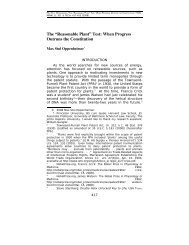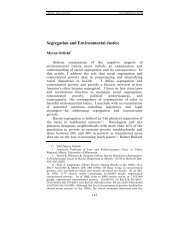An Organizational Approach to the Design of Patent Law
An Organizational Approach to the Design of Patent Law
An Organizational Approach to the Design of Patent Law
You also want an ePaper? Increase the reach of your titles
YUMPU automatically turns print PDFs into web optimized ePapers that Google loves.
6 VERTINSKY FINAL_JAD (DO NOT DELETE) 2/27/2012 2:20 PM<br />
2012] AN ORGANIZATIONAL APPROACH 245<br />
Although mostly fac<strong>to</strong>rs at this level are seen as constraints on<br />
formal rule change, formal rules can play a role in altering <strong>the</strong><br />
context <strong>of</strong> innovation. <strong>Patent</strong>s might alter not only <strong>the</strong> production<br />
<strong>of</strong> scientific discoveries, for example, but also <strong>the</strong> way in<br />
which science is unders<strong>to</strong>od. 153 <strong>Patent</strong>s might also have a<br />
transformative effect.<br />
3. Institutional Environment (Formal Rules)<br />
This level includes both <strong>the</strong> evolution and application <strong>of</strong><br />
patent rights and o<strong>the</strong>r formal rules relevant <strong>to</strong> innovation.<br />
The patent policy opportunities at this level involve making<br />
changes <strong>to</strong> patent rights <strong>to</strong> achieve desired objectives in light <strong>of</strong><br />
<strong>the</strong> existing transactional structures <strong>of</strong> innovation. 154 Much <strong>of</strong><br />
<strong>the</strong> NIE patent literature starts here, with questions about <strong>the</strong><br />
roles <strong>of</strong> patent “property” rights in creating possibilities for exchange.<br />
155 These branches <strong>of</strong> <strong>the</strong> literature have roots in<br />
Coase’s work on <strong>the</strong> importance <strong>of</strong> property rights in <strong>the</strong> presence<br />
<strong>of</strong> externalities, 156 with much <strong>of</strong> <strong>the</strong> work centering on <strong>the</strong><br />
definition and enforcement <strong>of</strong> patent rights, and <strong>the</strong>ir intersection<br />
with contract laws. 157 Using <strong>the</strong> transaction as <strong>the</strong> basic<br />
153. See, e.g., Peter Lee, Note, <strong>Patent</strong>s, Paradigm Shifts, and Progress in<br />
Biomedical Science, 114 YALE L.J. 659, 662 (2004) (Examines <strong>the</strong> contribution<br />
<strong>of</strong> patents <strong>to</strong> <strong>the</strong> advancement <strong>of</strong> scientific <strong>the</strong>ory—”<strong>the</strong> scientific community’s<br />
conceptual understanding <strong>of</strong> <strong>the</strong> basic structure and properties <strong>of</strong> natural<br />
phenomena.”).<br />
154. This framework shares Williamson’s assumption that while recognizing<br />
that legal constructs such as <strong>the</strong> patent system are <strong>the</strong> product <strong>of</strong> evolutionary<br />
processes and “constrained by <strong>the</strong> shadow <strong>of</strong> <strong>the</strong> past,” <strong>the</strong> legal system<br />
never<strong>the</strong>less provides design opportunities. Williamson, supra note 75, at<br />
598.<br />
155. See, e.g., MERGES, Institutions for Intellectual Property Transaction:<br />
The Case <strong>of</strong> <strong>Patent</strong> Pools, in INTELLECTUAL PRODUCTS: NOVEL CLAIMS TO<br />
PROTECTION AND THEIR BOUNDARIES 5 (2001) (“Property rights are important<br />
because <strong>the</strong>y necessitate and structure transactions.”); John F. Duffy, Rethinking<br />
<strong>the</strong> Prospect Theory <strong>of</strong> <strong>Patent</strong>s, 71 U. CHI. L. REV. 439 (2004). Merges examines<br />
<strong>the</strong> intersection <strong>of</strong> property rights and contract and suggests two major<br />
contributions that property rights make <strong>to</strong> real world contracting—precontractual<br />
liability and enforcement flexibility. See also Merges, supra note<br />
15.<br />
156. See R. H. Coase, The Problem <strong>of</strong> Social Cost, 3 J.L. & ECON. 1 (1960)<br />
(explaining <strong>the</strong> importance <strong>of</strong> property rights in <strong>the</strong> presence <strong>of</strong> transaction<br />
costs); Armen A. Alchian & Harold Demsetz, Production, Information Costs,<br />
and Economic Organization, 62 AM. ECON. REV. 777, 783–85 (1972) (explaining<br />
<strong>the</strong> emergence <strong>of</strong> <strong>the</strong> firm in terms <strong>of</strong> information costs and looking at <strong>the</strong><br />
impact <strong>of</strong> alternative allocations <strong>of</strong> property rights on problems inherent in<br />
team production).<br />
157. See Williamson, supra note 75.






